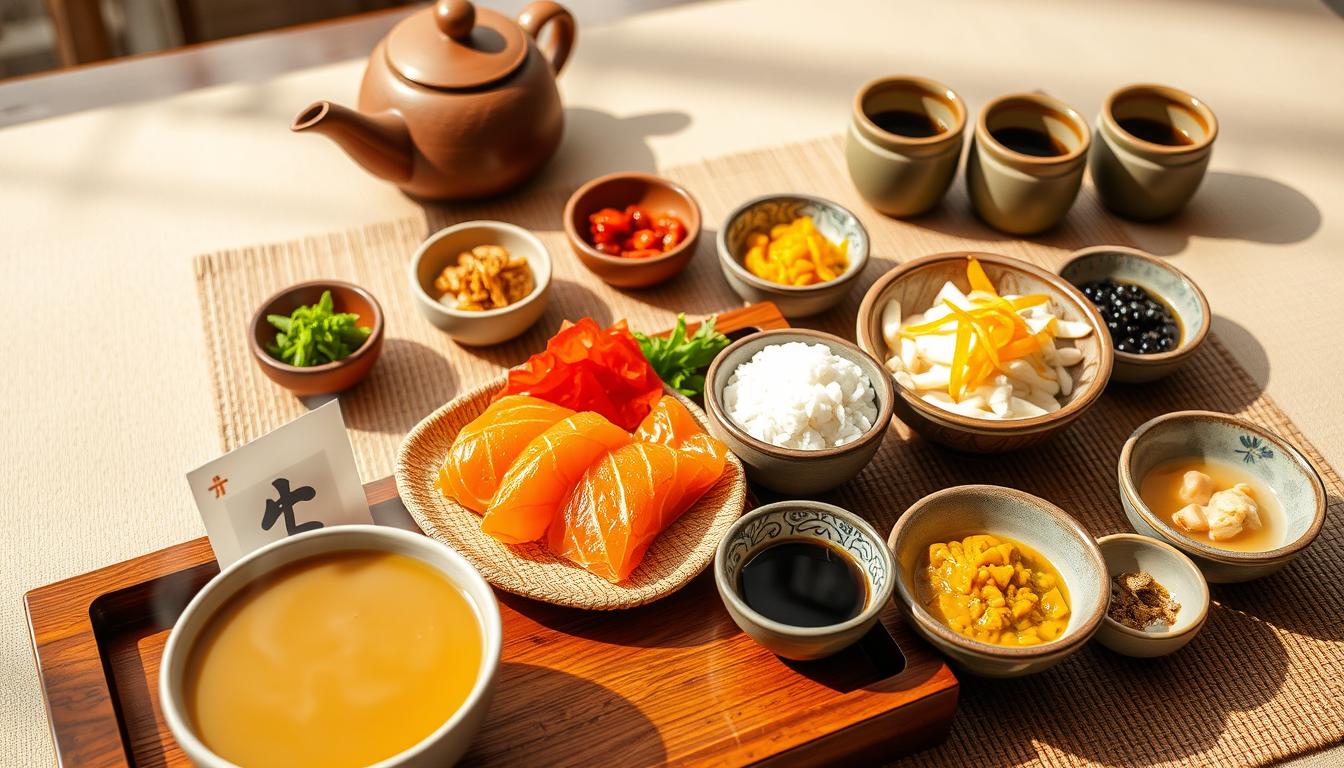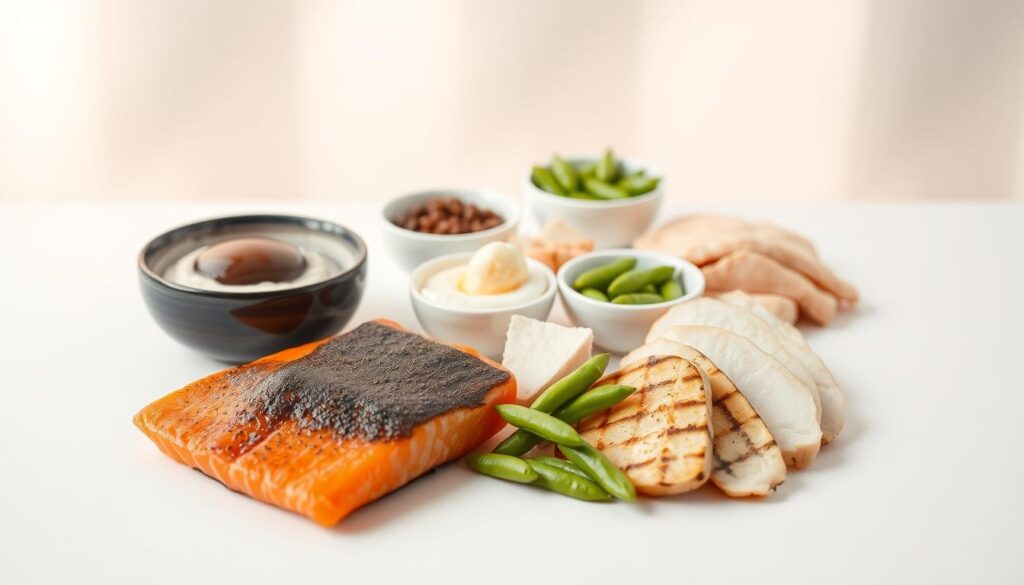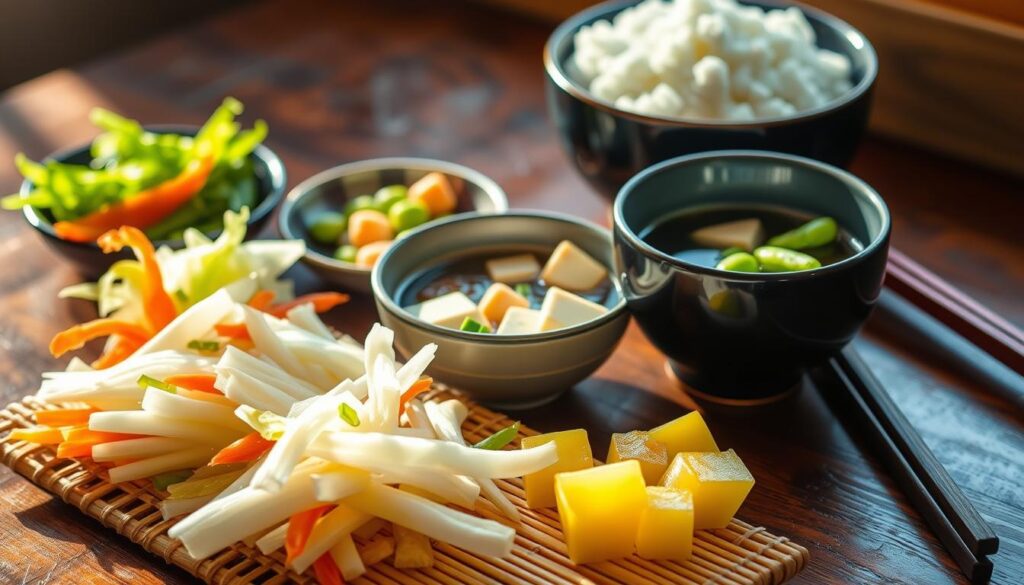Your Guide to Quick and Easy Japanese Breakfast Ideas

Starting your day with a nutritionally balanced meal can make all the difference in your morning routine. A traditional Japanese breakfast typically consists of steamed rice, miso soup, a protein source like grilled fish or eggs, and side dishes such as pickled vegetables.
In today’s fast-paced world, adapting this traditional breakfast to suit busy mornings is crucial. By incorporating time-saving techniques and simplified recipes, you can enjoy a delicious and healthy morning meal that sets you up for success.
A Japanese breakfast offers a harmonious combination of carbohydrates, proteins, and vegetables, providing sustained energy throughout the morning. With a few simple adjustments, you can make this traditional meal a part of your daily routine.
Key Takeaways
- Discover time-saving techniques for preparing a traditional Japanese breakfast.
- Learn how to simplify recipes to suit busy modern mornings.
- Understand the importance of a nutritionally balanced breakfast.
- Explore convenient substitutions for a quick morning meal.
- Assemble a nutritious Japanese-style breakfast in minutes.
Understanding Traditional Japanese Breakfast
Understanding the traditional Japanese breakfast requires exploring its key components and the nutritional benefits they offer. A traditional Japanese breakfast is more than just a meal; it’s a carefully balanced combination of various food groups designed to provide sustained energy and support overall health.
The traditional Japanese breakfast typically includes a variety of dishes that work together to create a balanced meal. This balance is achieved through the inclusion of carbohydrates, protein, fiber, and other essential nutrients.
Key Components of a Japanese Breakfast
A traditional Japanese breakfast consists of several key components, including steamedrice,fishor other protein sources, and an assortment ofvegetables. These components are often served alongside miso soup and pickled vegetables, creating a well-rounded meal.
Nutritional Benefits of Japanese Breakfast
Thetraditional Japanese breakfastoffers numerous nutritional benefits. Some of the key advantages include:
- A comprehensive nutritional profile that includes complex carbohydrates from rice, high-quality proteins from fish or eggs, and fiber from vegetables.
- Omega-3 fatty acids found in fish components like salmon or mackerel support brain function and reduce inflammation.
- Fermented foods such as miso and pickled vegetables deliver probiotics that promote gut health and improved digestion.
- A balanced combination of nutrients helps stabilize blood sugar levels, preventing mid-morning energy crashes.
By incorporating these nutrient-dense foods into your breakfast routine, you can enjoy sustained energy and mental clarity throughout the morning hours. The variety of food groups in a single meal ensures a wide spectrum of vitamins and antioxidants to support immune function.
Essential Ingredients for Quick and Easy Japanese Breakfast Ideas
You can make a delicious Japanese breakfast in minutes with the right ingredients. Although it may seem like a lot of work, preparing a Japanese breakfast can be effortless if you plan ahead.
Staple Ingredients to Keep on Hand
To make a traditional Japanese breakfast, you’ll need some staple ingredients. These include Japanese rice, miso soup mix, and various seasonings like soy sauce and furikake. Having these ingredients on hand will allow you to prepare a meal quickly.
Time-Saving Substitutions
When you’re short on time, there are several substitutions you can make to still enjoy a Japanese breakfast. Some convenient options include:
- Microwaveable rice pouches ready in 90 seconds
- Instant miso soup packets that can be prepared in under 2 minutes
- Pre-cooked salmon portions that just need reheating
- Hard-boiled eggs prepared in advance
| Ingredient | Traditional Option | Time-Saving Alternative |
|---|---|---|
| Rice | Freshly steamed Japanese rice | Microwaveable rice pouches |
| Miso Soup | Homemade miso soup with dashi broth | Instant miso soup packets |
| Protein | Grilled salmon | Pre-cooked salmon portions |
Preparing Rice for Japanese Breakfast
Rice is the cornerstone of a Japanese breakfast, and preparing it correctly is essential. Thanks to the previous night’s dinner, you can quickly decide what works for breakfast and reheat leftovers.
Using a Rice Cooker Timer Function
One of the most convenient ways to have freshly cooked rice for breakfast is by using a rice cooker with a timer function. This allows you to set the cooking time in advance, so your rice is ready when you wake up.
Quick Alternatives to Freshly Steamed Rice
If you don’t have a rice cooker or prefer not to use it, there are several quick alternatives. You can refresh leftover rice from dinner by sprinkling it with water and microwaving it covered for 1-2 minutes. Other options include using pre-cooked shelf-stable rice packets that need only 90 seconds in the microwave, or frozen rice portions that thaw and reheat quickly.
| Method | Time Required | Convenience Level |
|---|---|---|
| Refreshing Leftover Rice | 1-2 minutes | High |
| Pre-cooked Rice Packets | 90 seconds | Very High |
| Frozen Rice Portions | 2-3 minutes | High |
Simple Protein Options
Protein plays a vital role in a Japanese breakfast, and there are several simple options to choose from. You can easily incorporate protein into your meal with a variety of quick and easy dishes.
Quick-Cook Salted Salmon
One of the simplest protein options is quick-cook salted salmon. Salmon is a staple in Japanese cuisine, rich in omega-3 fatty acids and protein. To prepare it, you can season salmon fillets with salt and cook them in a pan until they’re nicely seared and cooked through. This method not only adds flavor but also provides a nutritious start to your day.
Easy Egg Dishes (Tamagoyaki and Onsen Tamago)
Eggs are another versatile protein source in Japanese breakfasts. Tamagoyaki, a Japanese-style rolled omelette, and Onsen Tamago, a hot spring egg, are two popular options. Tamagoyaki is made by rolling multiple layers of egg in a sweet and savory mixture, while Onsen Tamago is a soft-boiled egg with a creamy texture. Both dishes are not only delicious but also packed with protein.
No-Cook Protein Options (Natto and Pre-Cooked Fish)
For those with limited morning time, no-cook protein options are a lifesaver. Natto, or fermented soybeans, is a complete protein source with probiotic benefits. You can find pre-packaged natto in Japanese or Asian grocery stores, which can be stirred with the included sauce and mustard for a quick breakfast. Alternatively, pre-cooked fish products like salmon flakes can be sprinkled directly on rice without heating. Smoked salmon is another Western alternative that requires no cooking and provides similar nutritional benefits.

Other no-cook options include silken tofu with soy sauce and green onions, and pre-cooked, vacuum-sealed fish fillets that can be reheated briefly in the microwave. These options are particularly valuable for households where morning cooking noise might disturb sleeping family members.
5-Minute Miso Soup Recipes
You can make a delicious miso soup in just 5 minutes, perfect for a quick breakfast. The key is using ingredients that require minimal preparation.
Using Instant Dashi for Speed
Instant dashi granules can significantly speed up the process of making miso soup. Simply dissolve the granules in hot water to create a rich broth. Then, add miso paste and your choice of ingredients.
Quick Add-ins for Nutritious Miso Soup
To make your miso soup nutritious and filling, consider adding ingredients like pre-washed baby spinach, soft tofu, or pre-sliced mushrooms directly into the pot. You can also add whole eggs to create a poached effect or use pre-cooked ingredients like leftover chicken or fish. Other quick options include frozen vegetables and mixed sea vegetables that rehydrate instantly.
Fast and Simple Side Dishes
When it comes to Japanese breakfast, the side dishes play a crucial role in enhancing the overall dining experience. You can easily create a well-rounded meal by incorporating a few quick and simple sides.
Quick Cucumber and Seaweed Sides
For a refreshing side dish, consider preparing quick cucumber and seaweed salads. These can be made in minutes and add a delightful crunch to your breakfast. You can also use pre-made options available in Asian markets, such as individually packaged seaweed salads that require only opening the container.

Pre-Made Pickles and Vegetables
Japanese markets offer a variety of ready-to-eat pickled vegetables, known as tsukemono, which provide instant side dishes with zero preparation. You can pick up an assortment, including bright-yellow takuan (daikon pickle), fukujinzuke (a medley of pickled vegetables), or takana-zuke (a spicy pickle made from mustard leaves). Korean kimchi is also a great alternative, offering probiotic benefits and varying spice levels.
| Pickle Type | Description | Flavor Profile |
|---|---|---|
| Takuan | Yellow pickled daikon | Crunchy, sweet-tart |
| Fukujinzuke | Mixed vegetable pickle | Multiple textures and flavors |
| Takana-zuke | Spicy pickle made from mustard leaves | Spicy, tangy |
These store-bought options can be supplemented with homemade quick pickles when time allows, creating a varied breakfast experience throughout the week. As a bonus, pre-blanched spinach with sesame dressing is widely available in the prepared foods section of Asian markets, making it an easy and nutritious side dish option.
Putting It All Together: Sample 15-Minute Japanese Breakfast Menu
With a little preparation, you can enjoy a delicious and healthy Japanese breakfast in just 15 minutes. The key is to prepare some components the night before.
Start by setting your rice cooker timer for steamed rice, pre-salting salmon fillets, and preparing quick pickles to marinate overnight. In the morning, begin by making a 5-minute miso soup with spinach and egg, then broil the pre-salted salmon for 6-7 minutes.
Assemble your pre-prepared side dishes, including cucumber-seaweed quick pickle and store-bought takuan, and portion out the steamed rice. This efficient approach delivers a nutritionally complete breakfast with minimal morning effort.
This sample menu demonstrates how to prepare a complete meal using a simple recipe that can be customized based on seasonal availability and personal preferences.






